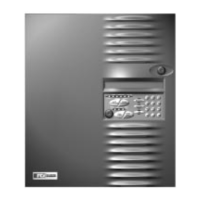3.1 Power
3.1.1 AC Input
Connection of the 120/240 VAC, 50/60 Hz power source must be made per the requirements of the National
Electrical Code, NFPA 70, Article 760, the applicable NFPA requirements, and/or the Authority Having
Jurisdiction.
Guidelines to follow are:
• Connections must be to a dedicated branch circuit
• Connections must be mechanically protected
• All means of disconnecting the circuit must be clearly marked: “FIRE ALARM CIRCUIT CONTROL.
• Accessible only to authorized personnel.
• For 240 VAC operation, no conductor shall have a potential greater than 150 V to ground.
See Table 1 for AC input and battery connections.
3.1.2 Battery Connections
TB7-1 is positive. See Table 1.
TB7-2 is negative. See Table 1.
Observe polarity
See Table 2 for Battery Calculations
3.1.3 Auxiliary Power Output, Resettable/non-resettable
TB4-1 Resettable, 24 VDC, max. 1.0 amp. Suitable for use with projected beam smoke detectors SPB-24,
770 Series, or DH Series duct detectors.
TB4-2 Non-resettable, 24 VDC, max. 1.0 amp. Suitable for use with the FM Series door holders.
NOTE: Total output is 1.0 amp max. combined.
TB4-3 Common negative
TB4-4 Not used
3.1.4 Earth Ground Connection
TB4-4 Earth Ground
3.2 Relay Connections
System Trouble Contacts
TB2-1 Normally Open
TB2-2 Common
TB2-3 Normally Closed
Transfers on any trouble condition and/or supervisory alarm.
System Alarm Contacts
TB2-4 Normally Open
TB2-5 Common
TB2-6 Normally Closed
Transfers upon any system alarm except supervisory.
Designation Description Comments
LEDs
LED25 Yellow Line 1 Trouble
LED26 Yellow Line 2 Trouble
Jumpers
W1 Not used
W2 OUT to disable battery
W3 IN - No Local Phone Line 1
W4 IN - No Local Phone Line 2
J6 Connection to keypad
JMP1 Cut for 240 VAC input operation
Table 1a - LEDs, Jumpers
IMPORTANT: Always apply AC power first, then connect the batteries.
14 of 43 9000-0447
Technical Manuals Online! - http://www.tech-man.com

